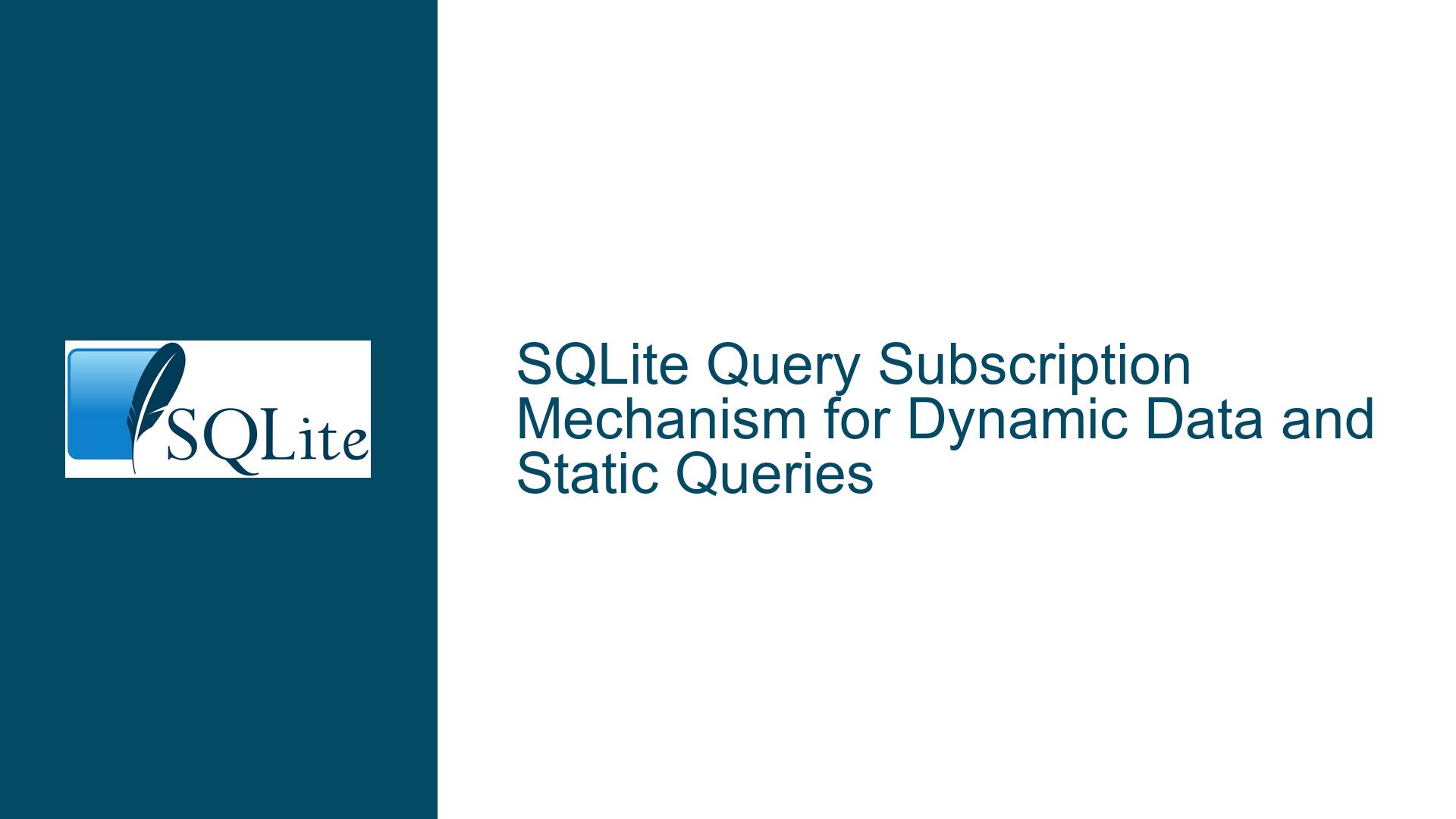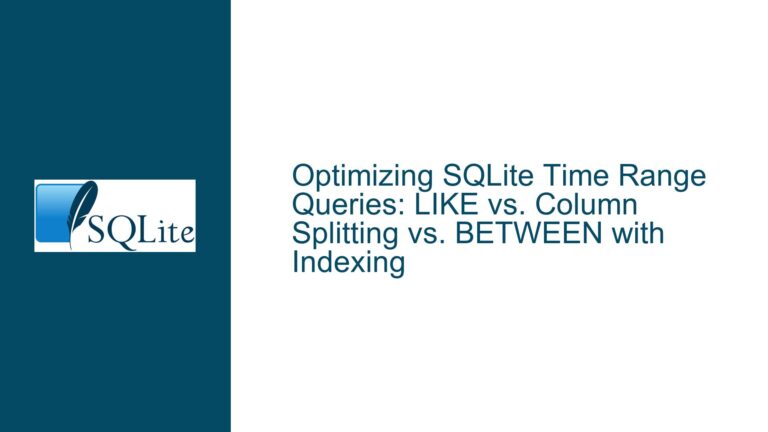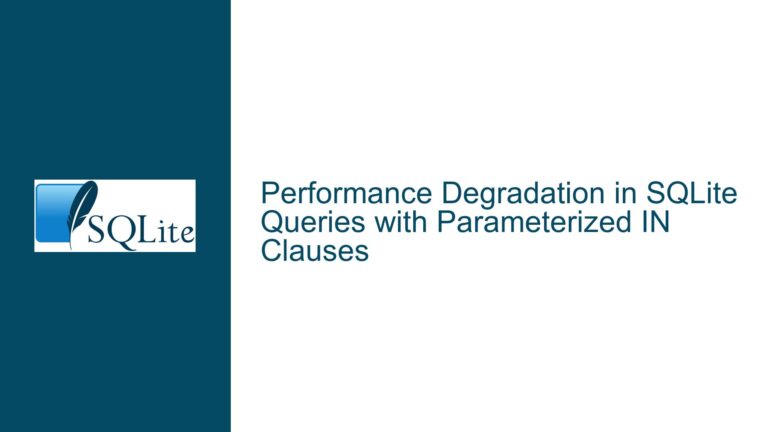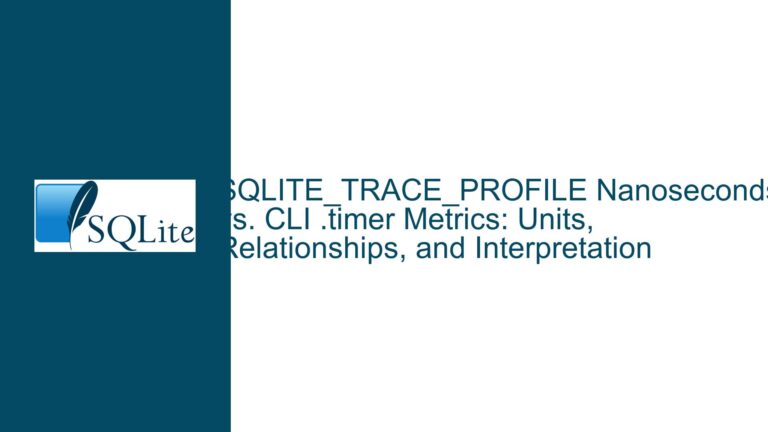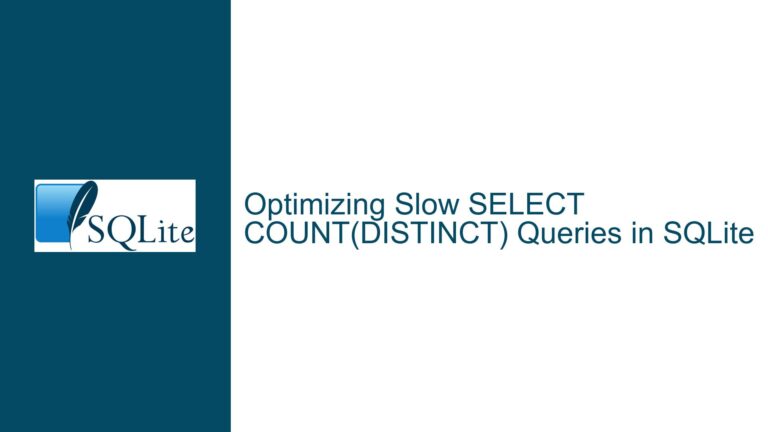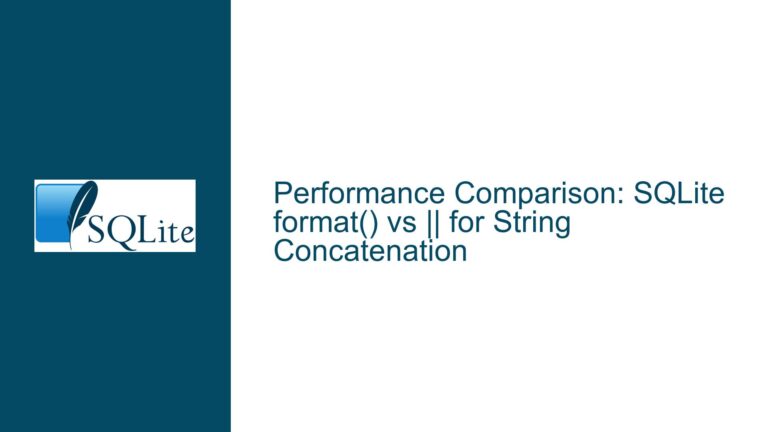SQLite Query Subscription Mechanism for Dynamic Data and Static Queries
Static Queries and Dynamic Data: The Core Challenge
The core issue revolves around the mismatch between the traditional database design philosophy and the modern application requirements. Traditional databases were designed with the assumption that data would be relatively static, and queries would be dynamic. However, modern applications often have the opposite requirement: static queries and dynamic data. This paradigm shift presents a significant challenge for databases like SQLite, which were not originally designed to handle this scenario efficiently.
In the context of SQLite, the primary challenge is to provide a mechanism that allows applications to subscribe to specific queries and receive notifications when the results of those queries change due to data modifications. This is particularly important for applications that rely on real-time data updates, such as dashboards, live feeds, or collaborative editing tools. The current SQLite architecture does not natively support such a query subscription mechanism, leading to inefficiencies and workarounds that can be both cumbersome and error-prone.
The problem is further compounded by the limitations of SQLite’s existing hooks and callbacks, such as the update_hook, which do not provide sufficient granularity or reliability for this use case. For instance, the update_hook does not work with WITHOUT ROWID tables, does not notify about changes from other connections or processes, and does not indicate which specific queries are impacted by a write operation. These limitations make it difficult to build a robust and scalable solution for applications that require real-time updates based on static queries.
Limitations of SQLite’s Update Hook and Callbacks
The update_hook in SQLite is a low-level mechanism that allows applications to register a callback function that is invoked whenever a row is updated, inserted, or deleted. While this hook can be useful for certain use cases, it falls short in providing the necessary functionality for applications that require real-time updates based on static queries. One of the primary limitations of the update_hook is that it does not work with WITHOUT ROWID tables, which are commonly used in SQLite for optimizing storage and performance in certain scenarios.
Another significant limitation is that the update_hook does not provide information about changes made by other connections or processes. This is a critical shortcoming for multi-process or multi-threaded applications where data modifications can occur concurrently from different sources. Without this information, it is impossible to maintain a consistent and up-to-date view of the data across different parts of the application.
Furthermore, the update_hook does not indicate which specific queries are impacted by a write operation. This means that even if an application is notified of a data change, it cannot determine which queries need to be re-evaluated or updated. This lack of granularity makes it difficult to implement an efficient query subscription mechanism, as the application would need to re-run all queries whenever any data change occurs, leading to unnecessary computational overhead.
Additionally, the update_hook calls the registered callback function before the transaction is committed. This can lead to situations where the application is notified of a change that is later rolled back, resulting in inconsistent or incorrect data being presented to the user. This behavior is particularly problematic for applications that require strong consistency guarantees.
Implementing Query Subscriptions with Partial Indexes and Imposter Tables
Given the limitations of SQLite’s built-in hooks and callbacks, one potential workaround is to use partial indexes and imposter tables to emulate a query subscription mechanism. This approach involves creating a partial index that includes only the rows that match the filtering conditions of the static query. By querying this index directly, the application can ensure that the result set is always up-to-date with the latest data modifications.
To implement this approach, the first step is to create a partial index that includes the filtering conditions of the static query. For example, if the static query is SELECT * FROM user WHERE name LIKE 'foo%', the corresponding partial index could be created as follows:
CREATE INDEX idx_user_name ON user(name) WHERE name LIKE 'foo%';
Next, an imposter table is created to represent the result set of the static query. This imposter table is essentially a virtual table that queries the partial index directly, ensuring that the result set is always up-to-date with the latest data modifications. The imposter table can be created using the CREATE TABLE statement with a SELECT clause that queries the partial index:
CREATE TABLE imposter_user AS SELECT * FROM user WHERE name LIKE 'foo%';
By querying the imposter table instead of the original table, the application can ensure that the result set is always consistent with the latest data modifications. However, it is important to note that this approach does not provide a delta of changes, meaning that the application will not be notified of specific changes to the result set. Instead, the application will need to re-query the imposter table whenever it needs to refresh the result set.
To address this limitation, the SQLite session extension can be used to track changes to the underlying data and generate a delta of changes. The session extension allows applications to capture changes made to a table or a set of tables and store them in a session object. This session object can then be used to apply the changes to another database or to generate a delta of changes that can be used to update the result set of the static query.
To use the session extension, the first step is to create a session object and attach it to the table or tables that are being monitored. This can be done using the sqlite3session_create function:
sqlite3session *pSession;
sqlite3session_create(db, "main", &pSession);
sqlite3session_attach(pSession, "user");
Once the session object is created and attached to the table, it will start capturing changes made to the table. These changes can then be retrieved using the sqlite3session_changeset function, which generates a changeset that can be applied to another database or used to update the result set of the static query:
void *pChangeset;
int nChangeset;
sqlite3session_changeset(pSession, &nChangeset, &pChangeset);
By combining partial indexes, imposter tables, and the session extension, it is possible to implement a query subscription mechanism in SQLite that provides real-time updates based on static queries. However, this approach requires careful management of the session object and the changeset, as well as additional logic to apply the changes to the result set of the static query.
Conclusion
The challenge of implementing a query subscription mechanism in SQLite for applications with static queries and dynamic data is a complex one, but it is not insurmountable. By leveraging partial indexes, imposter tables, and the session extension, it is possible to build a solution that provides real-time updates based on static queries. However, this approach requires a deep understanding of SQLite’s internals and careful management of the various components involved.
While the current limitations of SQLite’s built-in hooks and callbacks make it difficult to implement a robust and scalable query subscription mechanism, the techniques described in this post provide a viable workaround for applications that require real-time updates. As SQLite continues to evolve, it is possible that future versions will include native support for query subscriptions, making it easier for developers to build applications that rely on static queries and dynamic data. Until then, the techniques outlined in this post offer a practical solution for overcoming the limitations of SQLite’s current architecture.
